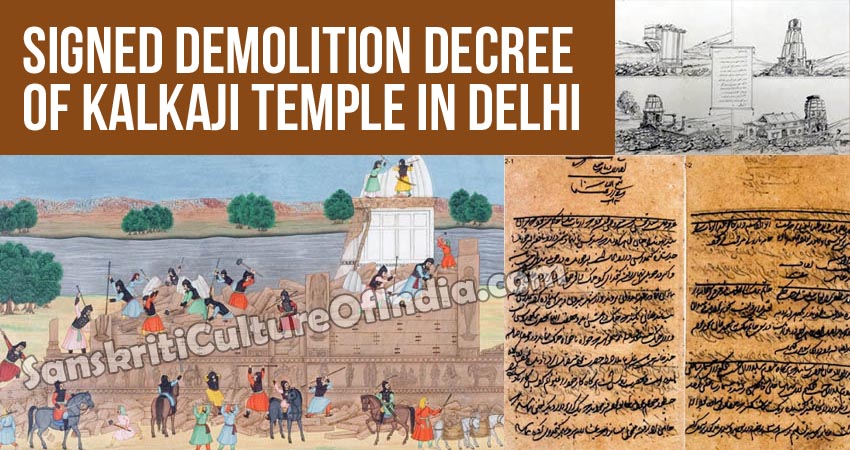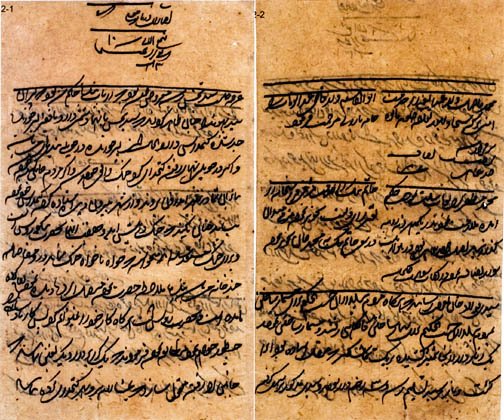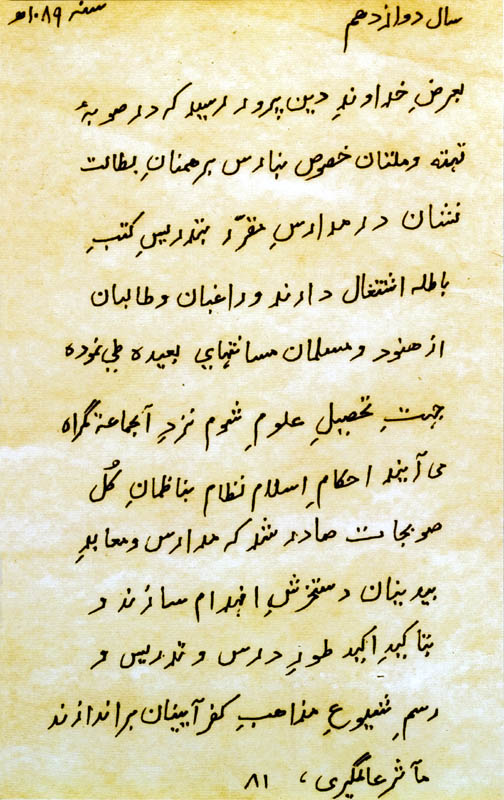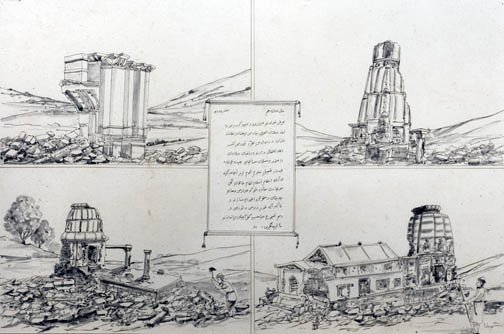3 September 1667
Emperor Aurangzeb issued a decree for demolishing the Kalka Temple, dedicated to the Mother Goddess. It’s what he wrote that is revealing of a senselessness that continues till date among the Taliban, Jihadists,ISI, Pakistan Army, Wahabis of Saud, Mullahs and orhtodox Muslimclerics everywhere, Kashmiri separatists, Jamaat-e-Islamists…
Translated, I am told, it reads:
“The asylum of Shariat (Shariat Panah) Qazi Abdul Muqaram has sent this arzi to the sublime Court : a man known to him told him that the Hindus gather in large numbers at Kalka’s temple near Barahapule (near Delhi); a large crowd of the Hindus is seen here.
“Likewise, large crowds are seen at (the mazars) of Khwaja Muinuddin, Shah Madar and Salar Masud Ghazi.
” This amounts to bid‘at (heresy) and deserves consideration.
” Whatever orders are required should be issued.”
The cleric’s request is immediately admitted by the highest arbiter of the land… a complaint based on hearsay… and
“Saiyad Faulad Khan was thereupon ordered (by the Emperor) to send one hundred beldars to demolish the Kalka temple, and other temples in its neighbourhood, which were in the Faujdari of Faulad Khan himself.
These men were to reach there post haste, and finish the work without a halt.”
* * *
The Kalka Temple which stands today was rebuilt soon after Aurangzeb’s death (1707 A.D.) on the remains of the old temple dedicated to Goddess Kali. Two Akhbarat dated Sept 3 and Sept 12, 1667, provide details regarding the demolition of the temple on Aurangzeb’s orders.
Since 1764, the temple has been renovated and altered several times but the main 18th Century structure remains the same, more or less. The site is very old dating back to Emperor Asoka’s time (3rd Century BC). There is mention of Kalka Temple in the Maratha records of 1738.
All through those centuries, people have flocked to the temple in large numbers, especially during Navratras twice a year.
“Saiyad Faulad Khan reported that, in compliance with the orders, beldars were sent to demolish the Kalka temple, which task they have done.
“During the course of the demolition, a Brahmin drew out a sword, killed a bystander and then turned back and attacked the Saiyad also. The Brahmin was arrested.”
* * *
There are only a few recorded instances of armed opposition by outraged Hindus, such as at Goner (near Jaipur), Ujjain, Udaipur and Khandela. But there were many more that have not been, of angry outbursts and resistance against Muslim vandalism… instances which did not make into official records of the Mughal state. And that is understandable in the era of deceit and intrigues, under an emperor who was known to be weak of the ear, suspicious, vindictive and brutal.Most of the Hindus took the destruction of these temples philosophically, considering these as acts of ignorance and folly, in vain and futile. They regarded it as a matter in accord with the little understanding of Musalmans, and their poor intelligence that left them incapable of comprehending the truth of the matter behind the idol worship or the fundamental oneness of saguna and nirguna worship.
The Hindus believed that Gods and Goddesses leave for their abode before the hatchet or the hammer of the vile destroyers – mlecchas andasuras – so much as even touched the idols.
The idea has been well described in Kanhadade Prabandha (1456 AD) while giving an account of the destruction of the Somnath temple by Sultan Alauddin’s troops in 1299.
* * *
General Order for the Destruction of Temples… 9th April, 1669
“The Lord Cherisher of the Faith learnt that in the provinces of Thatta, Multan, and especially at Benaras, the Brahmin misbelievers teach their false books, in their established schools, to admirers and students, both Hindu and Muslim, who come from great distances to these misguided men in order to acquire their vile learning.
“His Majesty, eager to establish Islam, issued orders to the governors of all the provinces to demolish the schools and temples of the infidels, and with utmost urgency, put down the teaching and the public practice of the religion of these unbelievers.”
This is not the only instance when Aurangzeb prevented the Muslims from acquiring knowledge and wisdom of the Hindu philosophical works and other Sanskrit and Bhasha classics, or sharing spiritual and intellectual experience. He thus stifled the process of fusion, or at least bridging of the gulf between the two creeds of very different approach, principles, values, levels of intellectual attainments and period over which their ideas evolved.
Instead, a ‘ general order ‘ of this type is issued to put down the teaching and public practice of religion by Hindu. There is no intelligible reason for such senseless acts, except profound hatred and fear or absence of critical capacity to examine and discriminate.
But the inferior mental assets of the Islamists proved very costly to people native to this land, as it continues to be in this age and time. They demolished some of the most lofty, beautiful and venerable shrines of India during the next few years !
However, nothing they could do took a speck away from Benares its unique position and prestige as the chief Vedic centre of learning, dharma shastras, the six philosophies, Sanksrit language and literature, and astronomy.
Eager to establish Islam, or at least perceived to be, Aurangzeb had on the 9th of April 1669 issued orders to governors of all provinces, to demolish schools and temples of the infidels… with utmost urgency, it must be stated, to put down the teaching and public practice of the religion of these (Hindus) unbelievers.
In the sketch above, the artist shows the destruction of hugely regarded temples at Somnath, Jagannath Puri, Benaras (Kashi Vishwanath) and Mathura (Keshava Rai)… all highly respected places of worship of some antiquity.
In the centre is a portion of the infamous order of the 9th April.
~ Ashok Tewari















